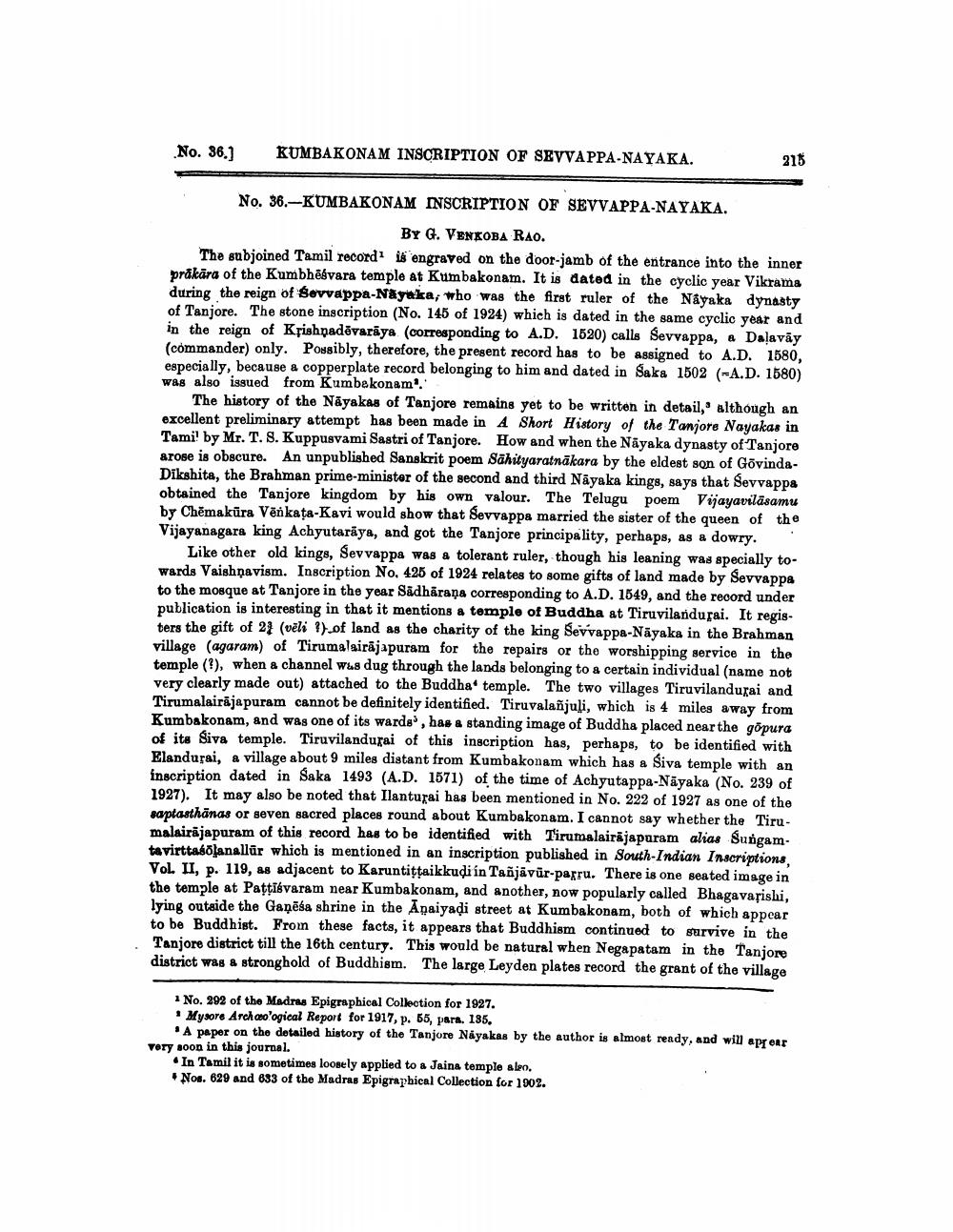________________
No. 36.]
KUMBAKONAM INSCRIPTION OF SEVVAPPA-NAYAKA.
215
No. 36.-KUMBAKONAM INSCRIPTION OF SEVVAPPA-NAYAKA.
BY G. VENKOBA RAO.
The subjoined Tamil record is engraved on the door-jamb of the entrance into the inner prākāra of the Kumbhêévara temple at Kumbakonam. It is dated in the cyclic year Vikrama during the reign of Sevvappa-Nayaka, who was the first ruler of the Nayaka dynasty of Tanjore. The stone inscription (No. 145 of 1924) which is dated in the same cyclic year and in the reign of Krishnadevaraya (corresponding to A.D. 1520) calls Sevvappa, a Dalavay (commander) only. Possibly, therefore, the present record has to be assigned to A.D. 1580, especially, because a copperplate record belonging to him and dated in Saka 1502 (-A.D. 1580) was also issued from Kumbakonam".
The history of the Nayakas of Tanjore remains yet to be written in detail, although an excellent preliminary attempt has been made in A Short History of the Tanjore Nayakas in Tami' by Mr. T. S. Kuppusvami Sastri of Tanjore. How and when the Nayaka dynasty of Tanjore arose is obscure. An unpublished Sanskrit poem Sahityaratnakara by the eldest son of GovindaDikshita, the Brahman prime-minister of the second and third Nayaka kings, says that Sevvappa obtained the Tanjore kingdom by his own valour. The Telugu poem Vijayavilāsamu by Chemakura Venkata-Kavi would show that Sevvappa married the sister of the queen of the Vijayanagara king Achyutaraya, and got the Tanjore principality, perhaps, as a dowry.
Like other old kings, Sevvappa was a tolerant ruler, though his leaning was specially towards Vaishnavism. Inscription No. 425 of 1924 relates to some gifts of land made by Sevvappa to the mosque at Tanjore in the year Sadharana corresponding to A.D. 1549, and the record under publication is interesting in that it mentions a temple of Buddha at Tiruvilandurai. It registers the gift of 2 (vēli ?) of land as the charity of the king Sevvappa-Nayaka in the Brahman village (agaram) of Tirumalairajapuram for the repairs or the worshipping service in the temple (?), when a channel was dug through the lands belonging to a certain individual (name not very clearly made out) attached to the Buddha temple. The two villages Tiruvilandurai and Tirumalairajapuram cannot be definitely identified. Tiruvalañjuli, which is 4 miles away from Kumbakonam, and was one of its wards', has a standing image of Buddha placed near the gopura of its Siva temple. Tiruvilandurai of this inscription has, perhaps, to be identified with Elandurai, a village about 9 miles distant from Kumbakonam which has a Siva temple with an inscription dated in Saka 1493 (A.D. 1571) of the time of Achyutappa-Nayaka (No. 239 of 1927). It may also be noted that Ilanturai has been mentioned in No. 222 of 1927 as one of the saptasthanas or seven sacred places round about Kumbakonam. I cannot say whether the Tirumalairajapuram of this record has to be identified with Tirumalairajapuram alias Sungamtavirttasõjanallur which is mentioned in an inscription published in South-Indian Inscriptions, Vol. II, p. 119, as adjacent to Karuntiṭṭaikkudi in Tañjavür-parru. There is one seated image in the temple at Paṭṭiévaram near Kumbakonam, and another, now popularly called Bhagavarishi, lying outside the Ganesa shrine in the Anaiyadi street at Kumbakonam, both of which appear to be Buddhist. From these facts, it appears that Buddhism continued to survive in the Tanjore district till the 16th century. This would be natural when Negapatam in the Tanjore district was a stronghold of Buddhism. The large Leyden plates record the grant of the village
1 No. 292 of the Madras Epigraphical Collection for 1927.
Mysore Archaeological Report for 1917, p. 55, para. 135,
A paper on the detailed history of the Tanjore Nayakas by the author is almost ready, and will appear very soon in this journal.
In Tamil it is sometimes loosely applied to a Jaina temple also. Nos. 629 and 633 of the Madras Epigraphical Collection for 1902.




